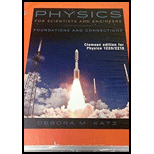
Concept explainers
(a)
The density of gasoline on a very hot day (
(a)
Answer to Problem 62PQ
The density of gasoline on a very hot day (
Explanation of Solution
Write the expression for the decreasing density of gasoline.
Here,
Rearrange the equation (I) for
Write the expression for the expansion of volume (Refer Equation 19.5).
Here,
Write the expression for the original density of gasoline.
Here,
Conclusion:
Substitute equation (II) in the equation (IV) and replace
Substitute equation (III) in above equation.
Here,
Convert initial temperature of the gas into degree Celsius.
Convert final temperature of the gas into degree Celsius.
Substitute
Therefore, the density of gasoline on a very hot day (
(b)
The mass of the gasoline purchased at a temperature of
(b)
Answer to Problem 62PQ
The mass of the gasoline purchased at a temperature of
Explanation of Solution
Rearrange the equation (IV) from part (a) for
Conclusion:
Substitute
Therefore, the mass of the gasoline purchased at a temperature of
(c)
The mass of the gasoline purchased at a temperature of
(c)
Answer to Problem 62PQ
The mass of the gasoline purchased at a temperature of
Explanation of Solution
Rearrange the equation (IV) from part (a) for
Conclusion:
Substitute
Therefore, the mass of the gasoline purchased at a temperature of
(d)
The amount of money did a consumer lose by buying gasoline on a very hot day.
(d)
Answer to Problem 62PQ
The amount of money did a consumer lose by buying gasoline on a very hot day is
Explanation of Solution
Since the consumer spent $30 for the 12 gallons of fuel, but on the hot day received 0.6 kg less compared to the 33.5 kg expected or 1.8% less.
Conclusion:
Hence, they lost about 1.8% of the $30 gas bill about
Therefore, the amount of money did a consumer lose by buying gasoline on a very hot day is
Want to see more full solutions like this?
Chapter 19 Solutions
Physics for Scientists and Engineers: Foundations and Connections
- A filmmaker wants to achieve an interesting visual effect by filming a scene through a converging lens with a focal length of 50.0 m. The lens is placed betwen the camera and a horse, which canters toward the camera at a constant speed of 7.9 m/s. The camera starts rolling when the horse is 36.0 m from the lens. Find the average speed of the image of the horse (a) during the first 2.0 s after the camera starts rolling and (b) during the following 2.0 s.arrow_forwardAnswer the question (Physics)arrow_forwardsolve smybolically and plug in numbers and solve at the endarrow_forward
- answer the question symbolically until you have to plug in numbers. show all work please.arrow_forwardWhat is the direction of the magnetic force on a NEGATIVE CHARGE that moves as shown in each of the six cases?arrow_forwardHi! I need help with these calculations for part i and part k for a physics Diffraction Lab. We used a slit width 0.4 mm to measure our pattern.arrow_forward
- Examine the data and % error values in Data Table 3 where the angular displacement of the simple pendulum decreased but the mass of the pendulum bob and the length of the pendulum remained constant. Describe whether or not your data shows that the period of the pendulum depends on the angular displacement of the pendulum bob, to within a reasonable percent error.arrow_forwardIn addition to the anyalysis of the graph, show mathematically that the slope of that line is 2π/√g . Using the slope of your line calculate the value of g and compare it to 9.8.arrow_forwardAn object is placed 24.1 cm to the left of a diverging lens (f = -6.51 cm). A concave mirror (f= 14.8 cm) is placed 30.2 cm to the right of the lens to form an image of the first image formed by the lens. Find the final image distance, measured relative to the mirror. (b) Is the final image real or virtual? (c) Is the final image upright or inverted with respect to the original object?arrow_forward
- Concept Simulation 26.4 provides the option of exploring the ray diagram that applies to this problem. The distance between an object and its image formed by a diverging lens is 5.90 cm. The focal length of the lens is -2.60 cm. Find (a) the image distance and (b) the object distance.arrow_forwardPls help ASAParrow_forwardPls help ASAParrow_forward
 Principles of Physics: A Calculus-Based TextPhysicsISBN:9781133104261Author:Raymond A. Serway, John W. JewettPublisher:Cengage Learning
Principles of Physics: A Calculus-Based TextPhysicsISBN:9781133104261Author:Raymond A. Serway, John W. JewettPublisher:Cengage Learning Physics for Scientists and Engineers: Foundations...PhysicsISBN:9781133939146Author:Katz, Debora M.Publisher:Cengage Learning
Physics for Scientists and Engineers: Foundations...PhysicsISBN:9781133939146Author:Katz, Debora M.Publisher:Cengage Learning College PhysicsPhysicsISBN:9781285737027Author:Raymond A. Serway, Chris VuillePublisher:Cengage Learning
College PhysicsPhysicsISBN:9781285737027Author:Raymond A. Serway, Chris VuillePublisher:Cengage Learning Physics for Scientists and Engineers, Technology ...PhysicsISBN:9781305116399Author:Raymond A. Serway, John W. JewettPublisher:Cengage Learning
Physics for Scientists and Engineers, Technology ...PhysicsISBN:9781305116399Author:Raymond A. Serway, John W. JewettPublisher:Cengage Learning An Introduction to Physical SciencePhysicsISBN:9781305079137Author:James Shipman, Jerry D. Wilson, Charles A. Higgins, Omar TorresPublisher:Cengage Learning
An Introduction to Physical SciencePhysicsISBN:9781305079137Author:James Shipman, Jerry D. Wilson, Charles A. Higgins, Omar TorresPublisher:Cengage Learning College PhysicsPhysicsISBN:9781305952300Author:Raymond A. Serway, Chris VuillePublisher:Cengage Learning
College PhysicsPhysicsISBN:9781305952300Author:Raymond A. Serway, Chris VuillePublisher:Cengage Learning





